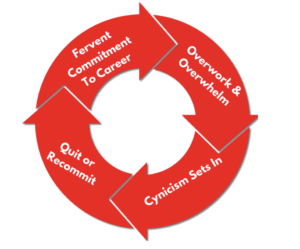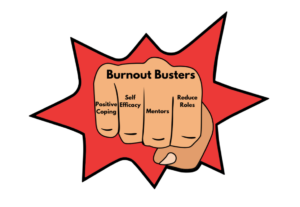By Kevin Leichtman
My father is my hero. He moves with a dedication to provide for his family in a way I believe is unmatched. I’ve seen him fill every role he possibly could to keep our family healthy, safe, and happy. Buying and selling homes, home sets, skirting, repairs, property management, trade shows… He’s done it all.
But perhaps his greatest achievement is this: He did it all without allowing himself to burn out.
Burnout is common in the labor market, including in the manufactured housing industry. Owners, managers, maintenance workers, and any other community roles are vulnerable to it. The impact is devastating and does not start and stop at your work. It invades every aspect of your life.
How Does Burnout Work?

The real danger of burnout is that it works quietly and in a cycle. It is easy to ignore feelings of burnout until it becomes insurmountable. By learning the cycle, you can learn to break it.
Stage 1: Fervent Commitment to Career
Burnout is a paradox. It is a phenomenon that hits the most committed and passionate workers, rendering them unable to remain committed and passionate to their work. Those who care the most, burnout the most. Stage 1 is idealistic and full of hope. Those ideals lead to an unstoppable desire to work harder and bring more value.
Stage 2: Overwork & Overwhelm
The most dedicated workers have a constant drive to improve. While that dedication is impressive, it quickly leads to overload. The balance between work and home life disintegrates. There is always another task to complete, another skill to learn or improve on, and another idea to implement. Overwhelm sets in with the feeling of never doing enough, no matter how much you have done.
Stage 3: Cynicism Sets In
What do the best workers get? More work. Stage 3 of burnout is the first moment where a person might physically and emotionally feel that they are burned out. The cynical community owner/worker begins to feel that their efforts are not paying off. Each initiative makes little difference. Extra work is met with more tasks while others slack. Each gain in profit seems to be met with another expense. This stage can be marked by a strong sense of pessimism and isolation. There also is a noticeable increase of sickness and hospital visits.
Stage 4: Quit or Recommit
While the other stages may last for months, years, or even decades, stage 4 is rapid. At this point, the person is completely depleted on a physical, mental, and emotional level. There are only two decisions left: will they quit, or find a way to recommit to the manufactured housing field?
We have all heard stories of mom-and-pop communities that sold even though they seemed to have the potential to move forward with ease. Or property managers who walked out with hardly any notice, even though they were incredibly talented and dedicated to their community. When burnout has completely drained someone, it takes a drastic change in perspective or environment to make a turnaround.
How to Beat Burnout
Positive Coping

What do you do when you are stressed? Negative coping mechanisms eat away at your health and give space for burnout to grow. It may be taboo to discuss, but drug and alcohol abuse harms many community owners, workers, and their families. It is easy to slip into dangerous routines to avoid the demands of a job.
It is time to lean on positive coping strategies. Exercise, nutrition, passion projects, active hobbies, and other healthy stress relieving activities are vital to reducing burnout.
Self-Efficacy
Studies show that self-efficacy impacts levels of burnout in a similar way to resiliency. The more you believe in your abilities, the less likely you are to burn out. Do and say things every day to build and reinforce your confidence in your work. Doubt creates overwork and lack of efficiency. Self-efficacy creates targeted work and optimistic fueled objectives.
Mentors
Did you know that burnout is contagious? Vent sessions among burned out peers make it more likely for you to become burned out. It can be a literal lifesaver for you to find an experienced mentor. If you are an owner, this is your cue to find a mentor for yourself and also place your employees with mentors who can help them. The cost of a solid mentorship program often is less than the cost of turnover, attrition, hiring, and training.
Reduce Roles
The most committed workers hate delegating roles. They thrive on accountability and take pride in their work. That seems great, until the impact on their health becomes greater. When you begin to reach the later stages of burnout, it may be time to cut back on your roles. Find your strengths and the greatest sources of your joy at work, then hire and delegate the areas that bring you the most stress. Protecting your headspace may be more valuable to your business and life than the value of doing it all yourself.
Crushing Burnout for Good
The largest barrier to burnout is that most people do nothing about it. The manufactured housing industry has a wide variety of stressors from every angle. If you take one of these burnout busting strategies and apply it today, there’s no telling the positive gains you may have personally and professionally. Reduce burnout to empower yourself to make a larger positive impact on your communities.










